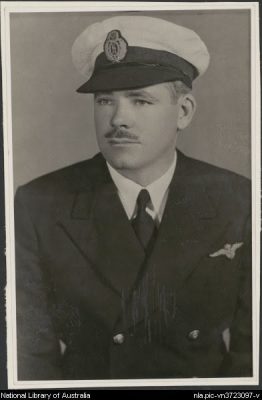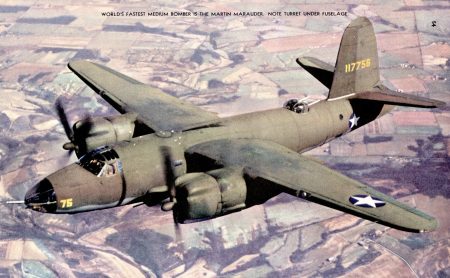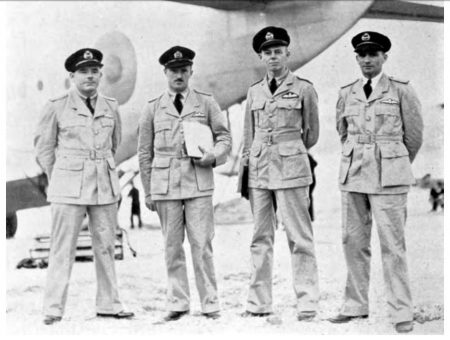Bob Gurney, the hero of Alotau

We remember a pioneering Australian aviator who was crucial to the development of air operations in Papua New Guinea. Roderick Eime recalls the exploits of Charles 'Bob' Gurney.
The Japanese installations around Simpson Harbour were already ablaze by the time the lone US Army Air Force (USAAF) B-26 Martin Marauder arrived to deliver its lethal payload. The rest of the 19th Bombardment Squadron had already been and gone, dropping their high explosives on the fuel dumps and ammunition stores piled around the shore of the otherwise idyllic harbour in the brooding shadow of Rabaul's Mt Tavurvur.
Despite the damage, enemy anti-aircraft gunners were primed and ready for the straggler. Separated from the other aircraft en route to the target after leaving their base at Kila Kila ,near Port Moresby. the twin-engined medium bomber and its seven crew bore the full force of their fury. In the cockpit was US pilot, 2nd Lt. Christian 'Chris' Herron along with his co-pilot, Squadron Leader Charles 'Bob' Gurney from Corowa, NSW.
Gurney, at 35, was an old hand at flying the dangerous routes around New Guinea and had been seconded to the USAAF to fast-track the Americans' air offensive against the invading Japanese Imperial Army and their naval support vessels.
It was the 2nd of May 1942 and the Japanese had ousted the small Australian garrison from Rabaul in January and set up an import forward base for operations against New Guinea. The first enemy troops had just landed in the Solomons and the pivotal Battle of the Coral Sea was just days away. Allied Forces were very much on the back foot in their early attempts to stem the Japanese tide and the turning points at Guadalcanal, Midway and Kokoda were still some months hence.

Inside the B-26 over Rabaul that fateful day, things were getting tense. Heavy shrapnel and 20mm shells were peppering the fuselage, piercing holes in the thin aluminium skin like hot fireballs.
“We're taking hits back here skipper,” called Gunner Fred Mikels over the intercom,”and there's smoke in the bomb bay!”
“Hold it steady, hold it …” urged bombardier George Barnhill, “.. okay .. BOMBS AWAY!”
As the clutch of 500lb bombs vacated the aircraft, the airframe lurched upward at the relief and they could begin the hazardous journey back across the Owen Stanley Range to the relative safety of Moresby. But things were rapidly coming unstuck for the crew of the B-26, so new it had yet to earn a nickname like so many of the 22nd Bombardment Group's battle-hardened planes. A 20mm shell had struck the port engine which responded by spraying hot oil over the wing and showering the jungle below with a momentary downpour of glowing metal sparks.
“We're not going to maintain altitude like this,” Gurney told his pilot plainly. Herron nodded in agreement and grabbed the intercom. “Get rid of everything we don't need back there.” Upon which .50 caliber machine guns, unused ammunition, empty fire extinguishers and sundry items were unceremoniously hurled out the bomb bay doors.
The dead engine was nothing more than ballast now but the pilots kept their cool despite the drama. This was certainly not the first emergency they'd faced in this unforgiving aviation environment. Gurney, in particular, had been flying since his early 20s when, in December 1925, he joined the fledgling RAAF at Point Cook, gaining early instruction under Alan Cross. After observing the young Gurney's natural talent for flying difficult aircraft, Cross later invited the cadet to join him in New Guinea as a pilot in the newly formed (now defunct) Guinea Airways.
Gurney took the very challenging task of piloting big, heavily loaded aircraft to the most rudimentary of airstrips in his stride. To call them airfields would be an exaggeration, as many of these rough bush strips were hacked out of raw jungle and cleared by hand. There was no hanging around in the hectic days of the early 1930s as gold was found and quickly exploited in the Wahgi Valley where there was no access except either by many days on foot from Salamaua on the coast or by air.
When Gurney started with Guinea Airways in November 1929, he was one of six fearless pilots flying two unwieldy German-built Junkers W34s and two much lighter British de Havilland Moths. After two years hauling all manner of bulky cargo to the new mine sites, bigger-still Junkers G31s were shipped out to Lae to carry yet more freight to the burgeoning mines operated by Bulolo Gold Dredging Ltd.
On one occasion in 1933, Gurney delivered a brand new Austin car to Wau and later, in that same G31, he flew a three-tonne generator to Bulolo in what was considered at the time to be a record-breaking feat in air cargo operations. Never mind the fact that when he landed, he wouldn't have had enough fuel left for a second attempt should the first approach have been unsuccessful.

Much to the relief of his wife, Jo, Gurney and three colleagues left Guinea Airways in 1936 for 'cushy' jobs with Qantas Empire Airways and for the next three years he helped pioneer many new routes for the airline as it reached out to the far corners of the Commonwealth. He flew the early de Havilland D.H.86s to Singapore, then later the ultra-luxurious Short Empire flying boats that revolutionised long-haul flying in the pre-war years.
At the outbreak of WWII, the big flying boats and their experienced crews were requisitioned by the RAAF for maritime reconnaissance. His squadron later converted to more practical PBY Catalinas. Attrition was high, with three of the crews killed within the first six months while conducting these dangerous missions.
So, with all that white-knuckle experience, it would seem that getting a modern, powerful – albeit handicapped – twin-engine bomber back to a safe landing would be a routine task for an old hand like Gurney. But it would not end so well.
Without the benefit of today's 'black boxes', no one can be sure what conversations took place in the cockpit that day, but the decision was made to attempt a wheels-down landing on a patch of flat grass on Kiriwina in the Trobriand Islands. While the five aircrew secured themselves in the rear of the plane, Herron lowered the undercarriage successfully and made the approach. When the wheels touched the ground, the 'grassy meadow' turned out to be a bog. The nose wheel snapped off, plunging the Plexiglas nose into the swamp and flipping the stricken aircraft on its back. Shaken, but not seriously injured, the crew climbed out the escape hatch in the belly and immediately went to the cockpit to assist the pilots. As they frantically worked to extricate a distressed Herron, the nose sank further into the swamp. The young pilot drowned in the murky water while it was clear Gurney had been killed outright on impact. Just two weeks before his 36th birthday, the heroic pioneer PNG aviator was dead.
Gurney's remains were eventually removed from the aircraft and his body buried in the Bomana War Cemetery at Port Moresby in grave A3.D.14.
In recognition of his many years of brave service, Gurney was posthumously awarded the Air Force Cross (AFC) and the airfield at Milne Bay named in his honour. Today Gurney Airport near Alotau is a busy domestic airport for Air Niugini and remembers, not only Bob Gurney but the many Australian and US service personnel who fought bravely from this base which held out against the might of the Imperial Army of Japan and helped secure victory. Lest we forget.